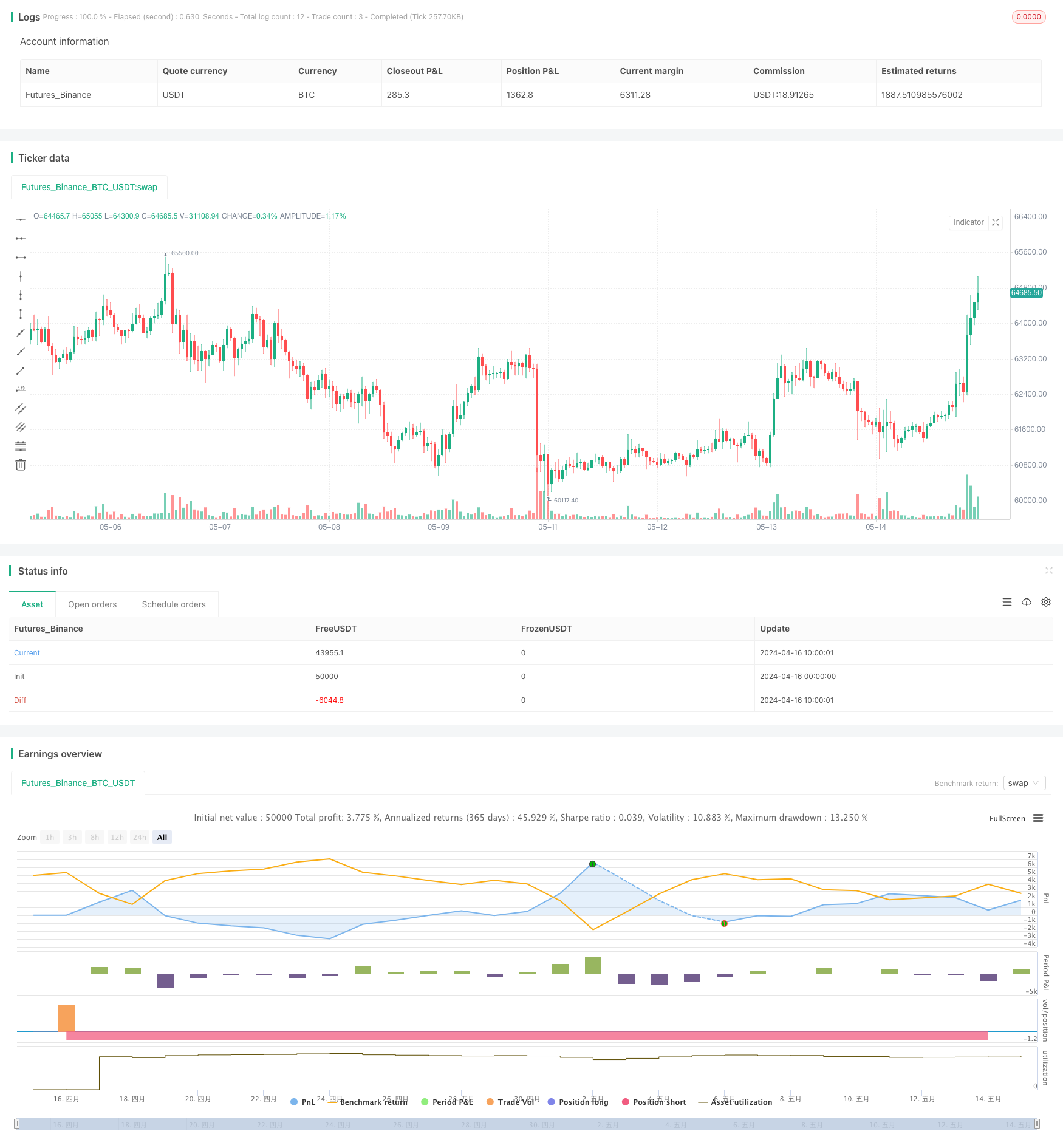
概述
该策略基于K线的连续上涨或下跌数目来判断牛市或熊市,并据此进行交易。当收盘价连续高于前一根K线的收盘价达到指定数目时,开多头仓位;当收盘价连续低于前一根K线的收盘价达到指定数目时,开空头仓位。同时设置了止损和止盈,并引入了移动止盈的机制以保护利润。
策略原理
- 记录连续多头和空头条件成立的次数。如果收盘价高于前一根K线,多头计数加1,空头计数重置为0;如果收盘价低于前一根K线,空头计数加1,多头计数重置为0;否则两个计数都重置为0。
- 当多头计数达到指定数目k时,开多头仓位,设置止损和止盈。
- 对于多头仓位,记录开仓后最高价,当最高价超过开仓价iTGT个最小变动单位,且收盘价回撤至最高价下方iPcnt%时,平仓。
- 当空头计数达到指定数目k2时,开空头仓位,设置止损和止盈。
- 对于空头仓位,记录开仓后最低价,当最低价低于开仓价iTGT个最小变动单位,且收盘价反弹至最低价上方iPcnt%时,平仓。
策略优势
- 简单易懂,基于K线的连续性进行交易决策,逻辑清晰。
- 引入了移动止盈的机制,在价格朝有利方向运行一段距离后主动保护利润。
- 止损和止盈的设置可以有效控制风险和锁定利润。
- 参数可调,适用于不同的市场和交易风格。
策略风险
- 在震荡行情中,频繁的开平仓可能导致较大的滑点成本。
- 连续K线数目的判断受到市场噪音的影响,可能出现频繁的信号。
- 固定的止损和止盈点位可能无法适应市场的波动性变化。
策略优化方向
- 引入更多的技术指标,如均线、波动率等,辅助判断趋势的强度和方向。
- 优化移动止盈的触发条件,如根据ATR自适应调整回撤百分比。
- 采用更加动态的止损和止盈方式,如跟踪止损、阶梯式止盈等。
- 对参数进行优化,找到适合不同市场和品种的最优参数组合。
总结
该策略通过K线的连续性来捕捉牛熊趋势,同时设置了止损止盈以控制风险。移动止盈的引入可以更好地保护利润。但在震荡市中可能出现频繁信号,需要进一步优化信号的可靠性。此外,止损止盈的设置也可以更加灵活,以适应市场的动态变化。综合来看,该策略思路简单清晰,适合趋势性市场,但仍有优化的空间。
策略源码
/*backtest
start: 2024-04-16 00:00:00
end: 2024-05-16 00:00:00
period: 1h
basePeriod: 15m
exchanges: [{"eid":"Futures_Binance","currency":"BTC_USDT"}]
*/
//@version=5
strategy("K Consecutive Candles 數來寶V2", max_bars_back=300, overlay=true)
// 定義用戶輸入
k = input.int(3, title="Number of Consecutive Candles for Long", minval=1)
k2 = input.int(3, title="Number of Consecutive Candles for Short", minval=1)
stopLossTicks = input.int(500, title="Stop Loss (Ticks)")
takeProfitTicks = input.int(500, title="Take Profit (Ticks)")
iTGT = input.int(200,"iTGT") // 移動停利點
iPcnt = input.int(50,"iPcnt") // 移動停利%
var float TrailValue = 0
var float TrailExit = 0
var float vMP = 0
BarsSinceEntry = ta.barssince(strategy.position_size == 0)
vMP := strategy.position_size
// 创建一个包含键值对的字典
addArrayData(type, value) =>
alert_array = array.new_string()
array.push(alert_array, '"timenow": ' + str.tostring(timenow))
array.push(alert_array, '"seqNum": ' + str.tostring(value))
array.push(alert_array, '"type": "' + type + '"')
alertstring = '{' + array.join(alert_array,', ') + '}'
// 定義條件變量
var int countLong = 0 // 記錄連續多頭條件成立的次數
var int countShort = 0 // 記錄連續空頭條件成立的次數
// 計算連續大於或小於前一根的收盤價格的次數
if close > close[1]
countLong += 1
countShort := 0 // 重置空頭計數
else if close < close[1]
countShort += 1
countLong := 0 // 重置多頭計數
else
countLong := 0
countShort := 0
// 開設多頭倉位條件
if countLong >= k
strategy.entry("Long Entry", strategy.long)
strategy.exit("Exit Long", "Long Entry", loss=stopLossTicks, profit=takeProfitTicks)
if vMP>0
TrailValue := ta.highest(high,BarsSinceEntry)
TrailExit := TrailValue - iPcnt*0.01*(TrailValue - strategy.position_avg_price)
if TrailValue > strategy.position_avg_price + iTGT * syminfo.minmove/syminfo.pricescale and close < TrailExit
strategy.close("Long Entry", comment = "Trl_LX"+ str.tostring(close[0]))
// 開設空頭倉位條件
if countShort >= k2
strategy.entry("Short Entry", strategy.short)
strategy.exit("Exit Short", "Short Entry", loss=stopLossTicks, profit=takeProfitTicks)
if vMP<0
TrailValue := ta.lowest(low,BarsSinceEntry)
TrailExit := TrailValue - iPcnt*0.01*(TrailValue - strategy.position_avg_price)
if TrailValue < strategy.position_avg_price - iTGT * syminfo.minmove/syminfo.pricescale and close > TrailExit
strategy.close("short60", comment = "Trl_SX"+ str.tostring(close[0]))
相关推荐